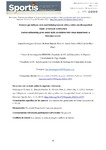Factores que influyen en la motricidad gruesa de niños y niñas con discapacidad visual: revisión de la literatura

Use this link to cite
http://hdl.handle.net/2183/30096
Except where otherwise noted, this item's license is described as Atribución-NoComercial-SinDerivadas 4.0 Internacional (CC BY-NC-ND 4.0)
Collections
Metadata
Show full item recordTitle
Factores que influyen en la motricidad gruesa de niños y niñas con discapacidad visual: revisión de la literaturaAlternative Title(s)
Factors Influencing Gross Motor Skills in Children With Visual Impairment: A Literature ReviewDate
2021-12-27Citation
Domínguez Álvarez, L., Barcala Furelos, R., Peixoto Pino, L., & Rico Díaz, J. (2021). Factores que influyen en la motricidad gruesa de niños y niñas con discapacidad visual: revisión de la literatura. Sportis. Scientific Journal of School Sport, Physical Education and Psychomotricity, 8(1), 40-59. https://doi.org/10.17979/sportis.2022.8.1.8777
Abstract
[Resumen] Los niños y niñas con discapacidad visual padecen retrasos en el desarrollo motor. La intervención y estimulación motriz desde la primera infancia puede atenuar el déficit motor y contribuir a un estilo de vida más activo. El objetivo de este trabajo es identificar y analizar la bibliografía existente sobre aquellos factores que pueden influir en el desarrollo de la motricidad gruesa en niños y niñas de 0 a 12 años con discapacidad visual o ceguera. Para ello, se realizó una búsqueda en tres bases de datos referentes (PubMed, Scopus y SPORTDiscus), siguiendo las pautas de la declaración PRISMA para revisiones. De los 130 artículos seleccionados en la revisión, se incluyeron 18 para el análisis cualitativo. Las evidencias encontradas se relacionan en tres bloques de resultados: 1) la influencia del grado de visión con la adquisición de las habilidades motrices gruesas, 2) la retroalimentación es un elemento favorecedor en las personas con déficit visual en la consecución de estas habilidades y la atenuación de la diferencia con los normo-videntes y 3) el nivel de competencia motriz y la práctica de actividad física y su relación con la adherencia a un estilo de vida activo. Se encontró una relación negativa entre la discapacidad visual y el desarrollo de la motricidad gruesa, con lo que contribuye a generar estilos de vida inactiva entre esta población. El uso de mecanismos de retroalimentación, una evaluación temprana del desarrollo motriz e intervenciones adaptadas desde la infancia, podrían mejorar la situación. [Abstract] Children with visual impairment have delays in motor development. Intervention and motor stimulation since early childhood can attenuate motor deficits and contribute to a more active lifestyle. The aim of this research is to identify and analyze the existing bibliography on factors that can influence the development of gross motor skills in boys and girls from 0 to12 years old with visual impairment or blindness. To do this, a search was carried out in three reference databases (PubMed, Scopus and Sportdiscus), following the guidelines of the PRISMA declaration for reviews. Out of the 130 articles selected in the review of the topic, 18 were included for the qualitative analysis. The evidence found can be related to three blocks of results: 1) the degree of vision has an influence in the acquisition of gross motor skills, 2) receiving feedback works favorably for people with visual impairments, in the achievement of these skills, as it reduces the gap with normo-sighted people and 3) the level of motor competence and the practice of physical activity are directly linked to a steadily active lifestyle. A negative relationship was found between visual impairment and gross motor development, which contributes to generating inactive lifestyles among this population. The use of feedback mechanisms, an early assessment of motor development and interventions adapted from infancy, could improve the situation.
Keywords
Discapacidad visual
Ceguera
Motricidad gruesa
Habilidades motrices básicas
Infancia
Visual impairment
Blindness
Gross motor skills
Basic motor skills
Childhood
Ceguera
Motricidad gruesa
Habilidades motrices básicas
Infancia
Visual impairment
Blindness
Gross motor skills
Basic motor skills
Childhood
Editor version
Rights
Atribución-NoComercial-SinDerivadas 4.0 Internacional (CC BY-NC-ND 4.0)
ISSN
2386-8333






